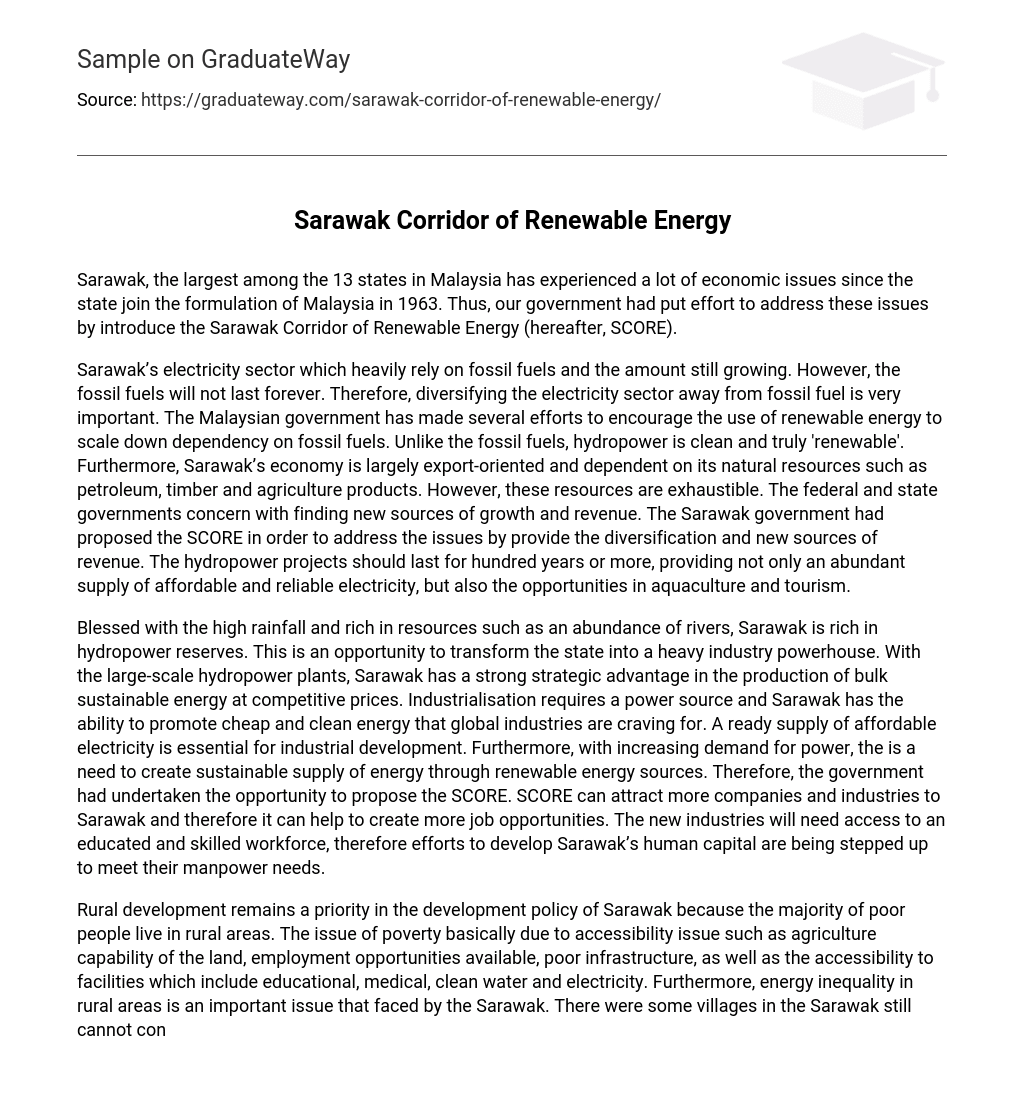Sarawak, the largest among the 13 states in Malaysia has experienced a lot of economic issues since the state join the formulation of Malaysia in 1963. Thus, our government had put effort to address these issues by introduce the Sarawak Corridor of Renewable Energy (hereafter, SCORE).
Sarawak’s electricity sector which heavily rely on fossil fuels and the amount still growing. However, the fossil fuels will not last forever. Therefore, diversifying the electricity sector away from fossil fuel is very important. The Malaysian government has made several efforts to encourage the use of renewable energy to scale down dependency on fossil fuels. Unlike the fossil fuels, hydropower is clean and truly ‘renewable’. Furthermore, Sarawak’s economy is largely export-oriented and dependent on its natural resources such as petroleum, timber and agriculture products. However, these resources are exhaustible.
The federal and state governments concern with finding new sources of growth and revenue. The Sarawak government had proposed the SCORE in order to address the issues by provide the diversification and new sources of revenue. The hydropower projects should last for hundred years or more, providing not only an abundant supply of affordable and reliable electricity, but also the opportunities in aquaculture and tourism.
Blessed with the high rainfall and rich in resources such as an abundance of rivers, Sarawak is rich in hydropower reserves. This is an opportunity to transform the state into a heavy industry powerhouse. With the large-scale hydropower plants, Sarawak has a strong strategic advantage in the production of bulk sustainable energy at competitive prices. Industrialisation requires a power source and Sarawak has the ability to promote cheap and clean energy that global industries are craving for.
A ready supply of affordable electricity is essential for industrial development. Furthermore, with increasing demand for power, the is a need to create sustainable supply of energy through renewable energy sources. Therefore, the government had undertaken the opportunity to propose the SCORE. SCORE can attract more companies and industries to Sarawak and therefore it can help to create more job opportunities. The new industries will need access to an educated and skilled workforce, therefore efforts to develop Sarawak’s human capital are being stepped up to meet their manpower needs.
Rural development remains a priority in the development policy of Sarawak because the majority of poor people live in rural areas. The issue of poverty basically due to accessibility issue such as agriculture capability of the land, employment opportunities available, poor infrastructure, as well as the accessibility to facilities which include educational, medical, clean water and electricity. Furthermore, energy inequality in rural areas is an important issue that faced by the Sarawak. There were some villages in the Sarawak still cannot connect to the main electricity grid. However, access to a reliable electricity is the basic right that the communities should have.
Therefore, SCORE established to increase the rural economy in Sarawak by increasing the accessibility. In this project, SCORE focuses on economic and infrastructure development. The SCORE’s project involved putting in place road bases, road furniture as well as road pavements; telecommunication and electrical infrastructure; water reticulation system; and water retention facility in growth nodes which include Tunoh, Baram, Samalaju, Mukah and Tanjung Manis. Regional development planning through implement the SCORE had been seen as one of the strategy to eradicate poverty issue in Sarawak.
Sarawak experienced the spatial inequality between the rural and urban area. Due to economic attractiveness and better quality of life, all towns are located in the coastal areas of Sarawak, including Kuching, Miri, Bintulu and Sibu, while most of rural areas in Sarawak still remains underdeveloped area. One of the factors that cause the uneven development was land development policy introduced by government.
In the Ninth Malaysia Plan (2006 – 2010), it was shows that the issue of spatial inequality in Sarawak has become widened and needs attention. Therefore, spatial development is very important in addressing this issues in order to achieve a balance growth distribution in the state. The launching of SCORE is a government effort to address the socio-spatial and developmental inequalities in Sarawak especially in rural area which was lagged due to imbalance development through regional development strategy.





